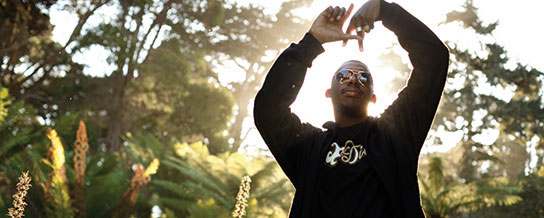Flying Lotus’ Artist Tips
L.A.-based instrumental hip-hop sculptor Flying Lotus (a.k.a. Steve Ellison) is a concept man first, gear […]

Flying Lotus’ Artist Tips
L.A.-based instrumental hip-hop sculptor Flying Lotus (a.k.a. Steve Ellison) is a concept man first, gear […]

L.A.-based instrumental hip-hop sculptor Flying Lotus (a.k.a. Steve Ellison) is a concept man first, gear hound second. His opus, 1983, is entirely indicative of that recording philosophy, and you’ll hear how his eerie, electro-fractured sounds are hardly the product of Guitar Center-studio foolery. Instead, they come from a place of mental organization, far away from the world of gear shops and plug-in downloads. Here, Ellison walks us through some important components in making a Flying Lotus recording.
1. Concept Cookie Crisp
A strong concept is the most important thing in creating a record. When you can listen to it and see a whole movie in your head, that’s what separates an instrumental album from a beat tape. When I made 1983, there were a bunch of tracks that were in the early drafts that didn’t make it because they just sounded like tracks for rappers, and that’s not really the sound I look for when I produce my own albums.
2. Toys and Shaker Thingies
I’m not really a gear junkie, and I don’t really think it matters if you use hardware or software, but I think if you are making an album you should try and have some consistency with the gear, especially the way you monitor your sounds. After I make a track, I like to burn it to CD and take a ride and hear how it hits. Even if it’s some mellow, folk-sounding shit, it has to knock. EQ and compression go a long way, especially for cats on the MPC.
3. Flux Capacitor 88
Before saying, ”This track is so dope, it’s gonna go on the album,” I like to take some time away from it and see how I feel about it in a few months. If it’s gonna get released, I gotta love it–it’s gonna have my name on it forever. I’m that guy who can’t hear his own work from a month ago. I’ll always hear something wrong with it because I go through different phases in my sound.
4. Green Tea Power
I’m not much of a coffee person, but when I wake up and the sun is shining through the window, I’ll get a lil’ bit of green tea and get to work. They say you’ll live a lil’ bit longer, too, by drinking this stuff. I’ll live forever… Bwa ha ha ha!
5. Hearing-Aid Click
When I have a sketch of an album, I’ll be really picky with the people I let hear it in its concept phase. They have to be in the same chamber of sound that I’m into at that moment, so you can really see where you stand and who you your audience is. If I can get the people who like beat music, that’s good. But if I get the people who like ”weird” music, then I know I’m headed in the right direction.
Support Independent Media
Music, in-depth features, artist content (sample packs, project files, mix downloads), news, and art, for only $3.99/month.

